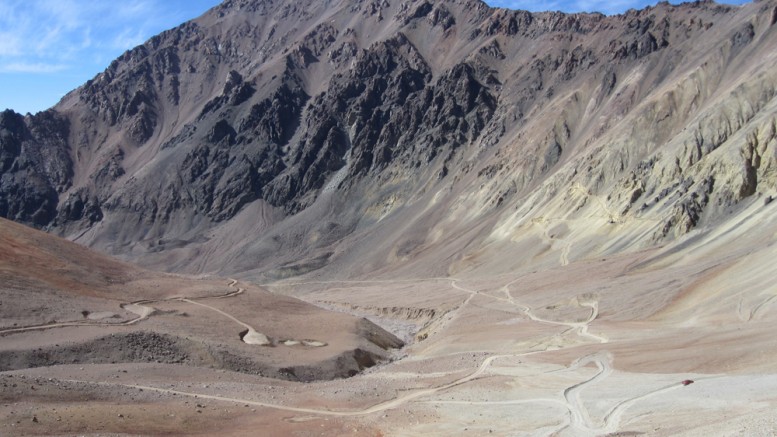VANCOUVER — Junior explorer NGEx Resources (TSX: NGQ; US-OTC: NGQRF) continues to expand mineralization at its Filo Del Sol project in a district it refers to as “Chile’s largest new copper-gold camp.” Bob Carmichael, vice-president of exploration, says the results will be incorporated into a new resource estimate, but for now his sights are set on something much bigger.
“The more we understand the geology at Filo Del Sol, the more we find ourselves looking towards the north,” he told the Mining Exploration Group (MEG) at a luncheon presentation in Vancouver. “We’ve come to realize that the deposit might actually be a small piece of something significantly larger that’s out there.”
Filo Del Sol is a silver-copper-gold epithermal deposit that straddles the border of between Chile and Argentina, 140 km southeast of the Chilean city of Copiapo. It’s located 17 km south of the company’s two other porphyry projects — Los Helados and Josemarie — which are jointly funded by Pan Pacific Copper and Japan Oil, Gas & Metals National (JOGMEC), respectively.
NGEx stepped 80 metres west and drilled along a 1.7 km strike-length of the existing inferred resource of 280 million tonnes grading 0.38% copper, 0.32 gram gold per tonne and 9.7 grams silver. The results were positive, with intercepts including 72 metres of 339 grams silver per tonne and 38 metres of 106 grams silver.
The bulk of the sulfide-oxide resource is contained within a shallow-dipping, permeable volcanic-layer that acted like a sponge to mineralizing fluids. But it’s the source of those fluids that Carmichael finds most intriguing.
“We’ve got gold scattered through the whole deposit, but to the north we start seeing grades increase over interesting lengths,” Carmichael said, while mentioning how alteration — a vector to mineralization — also picks up to the north.
“It’s easy to get distracted by the deposit, but we’ve taken a step back now and realized the target we’ve been chasing all along is a porphyry system, and Filo Del Sol could just be an extension of it,” he said.
NGEx is no stranger to success, which is likely why it’s been retained as the last pure-exploration vehicle in the Lundin Group of Companies. The junior first entered the property in 2004 with just a satellite image highlighting subtle alteration signatures, and since then it has increased its resource base seven-fold — an impressive value-add for a district most explorers had considered barren.
Its Los Helados and Josemarie resources amount to 2.89 billion tonnes grading 0.37% copper, 0.17 grams gold as indicated and 1.14 billion tonnes grading 0.31% copper and 0.12 grams gold as inferred. The total resource across the three deposits includes 15.3 million tonnes of copper, 22.0 million oz. gold and 87.8 million oz. silver using a 0.3 copper equivalent cut-off.
“We all know where we are in the cycle these days, it’s pretty doom and gloom out there,” Carmichael said. “But once metal prices come back, the major companies will go looking for the next generation mines. We think we’ve got them, and we’re focused on making them grow.”
Although finding ore deposits doesn’t appear too difficult for the explorer, it’s the bottom-line on development that poses the real challenge. The preliminary economic assessment (PEA) for its Los Helados deposit, completed last year, foresaw US$4.3 billion in capital expenditures and estimated a US$429-million after-tax net profit value and 9.4% internal rate of return.
“What kills you in this part of the world is the infrastructure,” Carmichael commented, adding that the PEA assumes Los Helados as a standalone project. “We are looking at combining Los Helados with some of the other mines in the area.”
One such opportunity lies with its 40% partner Pan Pacific Copper, which is a joint venture between Japan’s JX Nippon Mining & Metals and Mitsui Mining & Smelting. Pan Pacific operates the Caserones porphyry copper mine 20 km north of Los Helados.
On the other hand, Carmichael explains that Filo Del Sol is metallurgically different than its porphyry neighbors, and any ore processed from the deposit would have to be run through a different plant similar to Barrick Gold’s (TSX: ABX; NYSE: ABX) Veladero operations in Argentina.
Carmichael adds that any material-handling exercise far from discourages exploration across the company’s 60,000-hectare property.
“We’ve already found two nice porphyries and an epithermal deposit so we feel there’s real potential here to discover more within our land package,” he said.
NGEx has traded with a 52-week window of 92¢ to $2.38 and closed at 92¢ at press time. It has 187.7 million shares outstanding for a 172.7-million market capitalization.


Be the first to comment on "NGEx builds on discovery in Chile-Argentina"